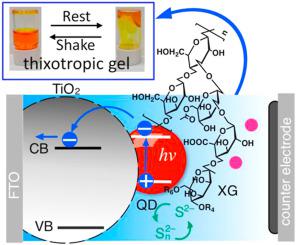Materials Today Energy ( IF 9.0 ) Pub Date : 2020-12-08 , DOI: 10.1016/j.mtener.2020.100615 A.S. Rasal , Y.-H. Chen , K. Dehvari , G. Getachew , P.-J. Tseng , K. Waki , S. Bela , J.-Y. Chang

|
In this article, the preparation of a gel electrolyte that consists of a polysulfide electrolyte with xanthan gum (XG) thixotropic gel and TiO2 nanoparticles (NPs) is reported for the development of improved performance of quantum-dot-sensitized solar cells (QDSSCs). Natural polysaccharide XG exhibited thixotropic sol−gel transitions, by which it can reversibly be converted from sols to high-viscosity gels under shear stress. XG is, for the first time, used to passivate the surface trap states or act as steric hindrance between TiO2/QDs/electrolyte interfaces. The incorporation of TiO2 NPs in the XG gel electrolyte improved the ionic conductivity of the gel electrolyte. For the Cu–In–Se QDSSC with gel electrolytes, the conversion efficiencies were 7.25% and 8.19% for XG and XG/NP gel electrolytes, respectively, whereas, the liquid electrolytes only delivered an efficiency of 6.86% under simulated sunlight (AM 1.5, 100 mW cm−2). Moreover, electrochemical analysis revealed that enhanced charge transfer and suppressed electron–hole recombination process occurred more frequently at the TiO2/QDs/electrolyte in QDSSCs with the XG/NP gel electrolyte compared with those with the liquid and XG gel electrolyte. Most importantly, the XG/NP gel electrolyte is also effective in various I-III-VI-based QDSSCs, including Cu–In–S and Ag–In–Se QDSSCs, for improving the cell power conversion efficiencies and stability because of the synergistic effect of XG and TiO2 NPs in polysulfide electrolytes. Notably, the best cell devices (Cu–In–S QDSSCs) constructed using XG/NP gel electrolytes have long-term stability under one-sun illumination, retaining 90% of the initial device's efficiency after 150 h.
中文翻译:

高效的量子点敏化太阳能电池,使用触变性聚合物/纳米粒子为基础的凝胶电解质,具有改善的稳定性
在本文中,报道了一种由多硫化物电解质与黄原胶(XG)触变凝胶和TiO 2纳米颗粒(NPs)组成的凝胶电解质的制备,用于开发量子点敏化太阳能电池(QDSSC)的改进性能。 。天然多糖XG表现出触变溶胶-凝胶转变,在剪切应力作用下,它可以可逆地从溶胶转变为高粘度凝胶。XG首次用于钝化表面陷阱态或充当TiO 2 / QDs /电解质界面之间的空间位阻。TiO 2的掺入XG凝胶电解质中的NP改善了凝胶电解质的离子电导率。对于使用凝胶电解质的Cu-In-Se QDSSC,XG和XG / NP凝胶电解质的转换效率分别为7.25%和8.19%,而在模拟阳光下,液体电解质的转换效率仅为6.86%(AM 1.5 ,100 mW cm -2)。此外,电化学分析表明,在TiO 2上,电荷转移增强和电子-空穴复合过程抑制更为频繁。带有XG / NP凝胶电解质的QDSSC中的/ QDs /电解质与带有液态和XG凝胶电解质的QDSSC中的/ QDs /电解质。最重要的是,XG / NP凝胶电解质在各种基于I-III-VI的QDSSC中也有效,包括Cu-In-S和Ag-In-Se QDSSC,由于具有协同作用,因此可以提高电池功率转换效率和稳定性。 XG和TiO 2 NPs在多硫化物电解质中的作用 值得注意的是,使用XG / NP凝胶电解质构造的最佳电池器件(Cu-In-S QDSSC)在单光照射下具有长期稳定性,在150小时后仍能保持初始器件效率的90%。









































 京公网安备 11010802027423号
京公网安备 11010802027423号